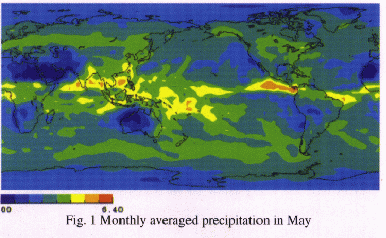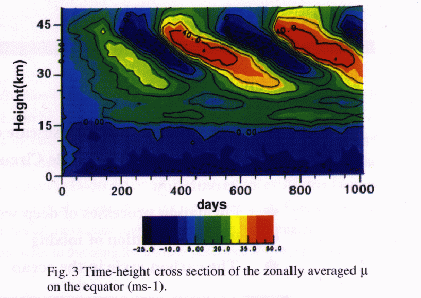 Atmospheric Modeling
Atmospheric Modeling Atmospheric Modeling
Atmospheric ModelingThe main task of the Atmospheric Modelling Section is to develop a new AGCM (Atmospheric General Circulation Model) and climate models to study global warming and ENSO prediction, to clarify the mechanism of variability of the climate system, and to investigate a feasibility of climate prediction.
 Research Subjects
Research Subjects Development of AGCM
Development of AGCMPresent climate models are considered to be deficient in their treatment of clouds and ocean. We have, therefore, been working to develop a second-generation AGCM jointly with NIES (National Institute for Environmental Studies) for better understanding of climate. Special attention is paid to moist processes in the AGCM. The AGCM is summarized in Table 1, and its main features are explained below;
(1) Special emphasis is placed on the improvement of moist processes for climate change. A new radiation code based on a k-distribution method is implemented. This is in preparation for more accurate treatment of radiation processes in a climate model. For example, the effect of aerosols will be investigated.
(2) Cloud water content is treated as a prognostic variable, and clouds in the radiation process can be treated consistently with convective processes.
(3) Higher horizontal and vertical resolution is being pursued. Preliminary results are shown in Figs. 1 and 2. In Fig.1, monthly averaged precipitation in May is displayed. Rainfall associated with the Asian Monsoon, ITCZ and baroclinic zone in the souther Hemisphere are well simulated. Height-latitude cross-section of zonally averaged zonal wind (u) in May is shown in Fig. 2. In general, it is consistent with observation.

 Research Activities Using Numerical Experimen
Research Activities Using Numerical ExperimenIt is one of the important mission to clarify the mechanism of natural variability of our climate system by conducting numerical experiments,where not only sophisticated models but also simplified models are used. For example, the QBO is being investigated by using a higher resolution sector model (T106L45), in which a QBO-like phenomenon is well simulated (Fig. 3).
Besides numerical experiments with global models, much research is being conducted to improve physical processes in the climate models.
(1) In order to increase accuracy and decrease computer time, further improvement is being introduced.
(2) Modeling of radiative effects of clouds is being developed.
(3) Mixed-layer processes are being investigated and validated with TOGA-COARE data.
(4) Semi-Lagrangian schemes are being investigated.


 Future Plan
Future PlanThe following is the research plan for the next 2 or 3 years;
(1) ENSO simulation and prediction, (2) Analysis of the annual cycle by using higher resolution AGCM, (3) CO2 doubling experiments.
It is one of the most important missions of CCSR to estimate the global warming due to the increase of greenhouse gases. As soon as a fully coupled ocean-atmosphere climate model is ready for experiments, numerical experiments similar to those in the IPCC report will be conducted. However, as a first step, several numerical experiments are planned using a climate model with a mixed layer ocean this year.
Horizontal Resolution T21 or T42 Vertical Resolution 20 levels Radiation Process DOM+k-distribution Convective Process Simplified Arakawa-Schubert Land Surface Fluxes Modified bucket model Surface fluxes Bulk method Boundarylayer process Meller Yamada level-2 closure model Gravity drag McFarlane (1987) Time Integration Leap frog and semi-implicit Cloud amount Determined by cloud water content
